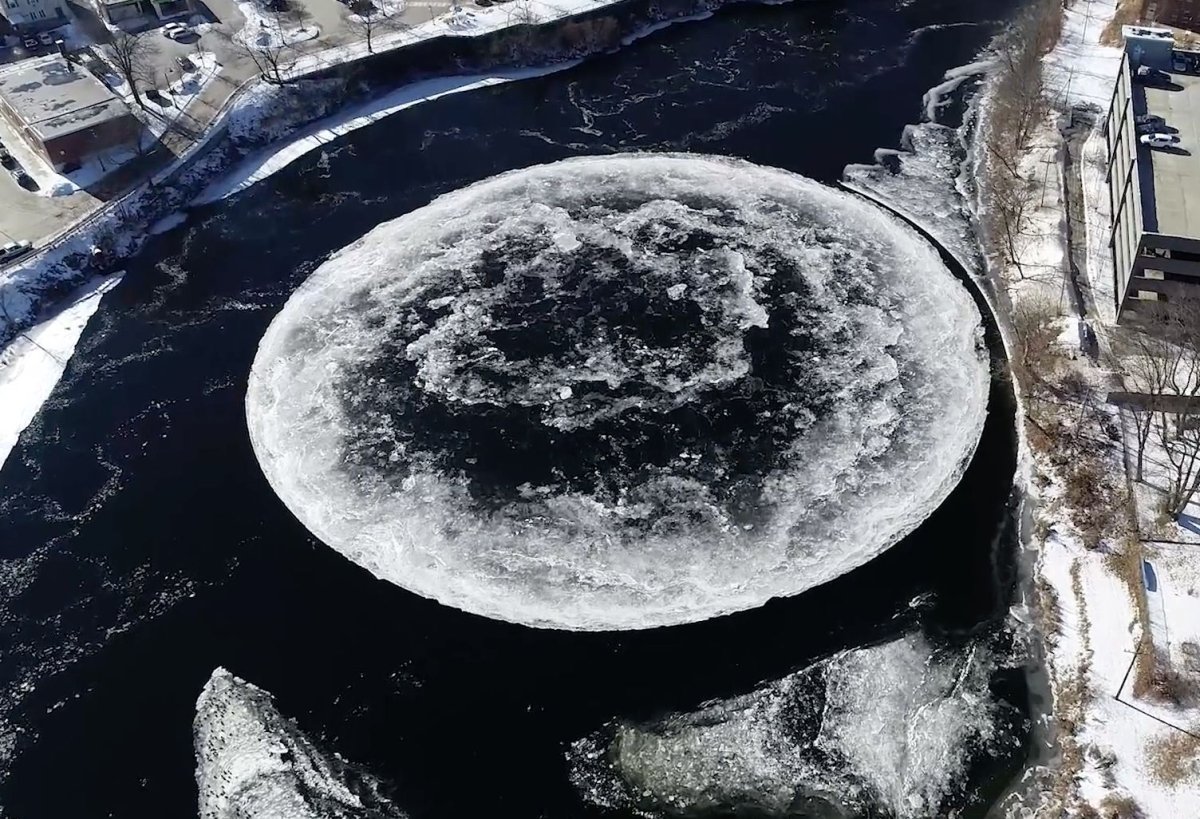A potentially world-record-breaking spinning disk of floating ice has appeared in a river in Maine, prompting comparisons to a crop circle.
The body, which has formed on the Presumpscot River in Westbrook, a suburb of Portland in Cumberland County, is approximately 300ft wide, the city's marketing and communications manager Tina Radel told Newsweek.
Read more: East Antarctica: World's largest ice sheet could melt under 2C warming with disastrous consequences
"It looks like the moon has landed in Westbrook!" the City of Westbrook posted on its official Facebook page alongside drone footage of the icy saucer.
Dubbing the object the Westbrook Ice Disk, the city encouraged locals to head down to the Presumpscot River to catch sight of it. It can be seen from River Walk near Ash Street, or behind the nearby Bank of America branch, the post said.
Westbrook, Maine Ice Disk - Presumpscot River from City of Westbrook, Maine on Vimeo.
Radel said she was alerted to the disk by a local business owner on January 14. "I spoke with a local bird-watcher who said he has been watching it form over a three-week period."
Among locals to head down to the riverside was Doug Bertlesman, who told the Press Herald: "It kind of looks like a crop circle." His web development firm is located on the fourth story of a building which looks out onto the river. He also said the disk appears to measure 100 yards in diameter, or around 300ft.
Local resident Bruce Small told CBS-affiliate WGME: "I wanted to see it for myself and take a few pictures."
Photos shared on the City of Westbrook Facebook page showed birds perched atop the spinning ice.
Cam Gordon, who works in the city, told WGME it was "nice to see the seagulls are having a nice ride and the ducks too."
Another local resident Rob Mitchell told the Press Herald: "There were ducks sitting on it. The ducks were rotating on this big Lazy Susan. It was a big duck-go-round."
Such disks can form when when icy sludge becomes frozen in an eddy or when a piece of ice starts to spin and is shaped as it hits water and rocks, TheNew York Times reported.
Professor John Huth, a physicist at Harvard University, explained to Newsweek how he believes the disk formed.
"Just upstream from the ice-wheel are a set of falls, and the river is constricted," he said. "Past the falls, it opens up into an embayment, and the fast water hugs the southern bank. Oftentimes, in a situation like this, an eddy or vortex of water forms that swirls backward. In this case the backward flow is along the northern bank. This pattern likely exists year-round in that part of the river."
"When the temperature drops below freezing, the first parts of a river to have ice formation are where there is little flow. The center of the eddy has little water flow, so it's natural that ice might start to form there. Eddies can also collect flotsam, as floating matter can get drawn in, but don't have a escape path. Likewise, floating ice was probably captured in the eddy."
And as temperatures were hovering around the freezing mark in the past few days, this likely allowed the disk to grow a bit during each cycle, while the river itself did not become solid on top. This enabled the ice wheel to take on the rotation of the eddy itself, he said.
Steven Daly of the Army Corps of Engineers' Cold Regions Research and Engineering Laboratory in Hanover, New Hampshire, told The New York Times that while the organization is alerted to one or two rotating ice disks in the country annually, they are rarely so large.
California Institute of Technology physics professor Kenneth G. Libbrecht said the disk might be of a "world-record size, if anybody were keeping track," and stated most formations measure between 20 to 30ft in diameter, The New York Times reported.
The Press Herald reported the disk has caused "almost as much" interest in the city as a reptile nicknamed Wessie found devouring a beaver in the river in 2016.
This article has been updated with comment from John Huth and Tina Radel.

Uncommon Knowledge
Newsweek is committed to challenging conventional wisdom and finding connections in the search for common ground.
Newsweek is committed to challenging conventional wisdom and finding connections in the search for common ground.
About the writer
Kashmira Gander is Deputy Science Editor at Newsweek. Her interests include health, gender, LGBTQIA+ issues, human rights, subcultures, music, and lifestyle. Her ... Read more
To read how Newsweek uses AI as a newsroom tool, Click here.








